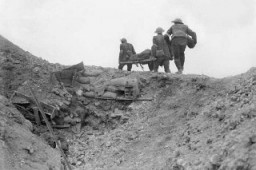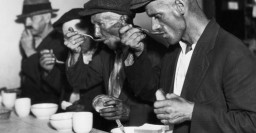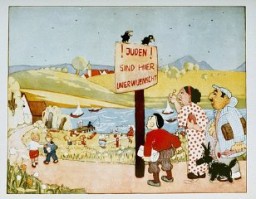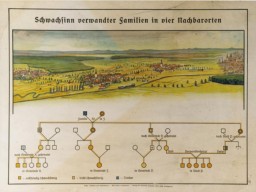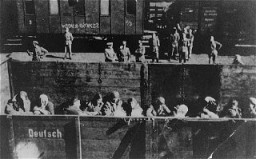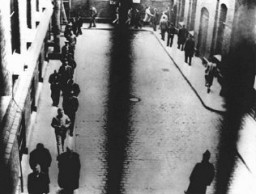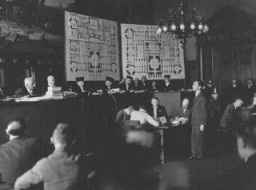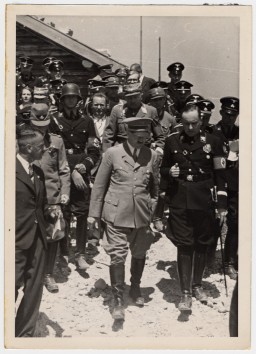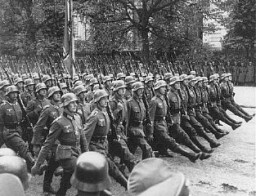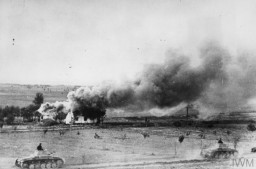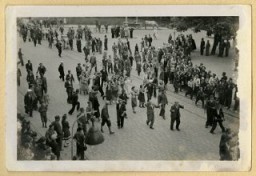
What conditions, ideologies, and ideas made the Holocaust possible?
The leaders of Nazi Germany, a modern, educated society, aimed to destroy millions of men, women, and children because of their Jewish identity. Understanding this process may help us to better understand the conditions under which mass violence is possible and to take steps to prevent such conditions from developing.
Explore fundamental questions about how and why the Holocaust was possible.
See related articles for background information related to this discussion.
The Holocaust was not a single event. It did not happen all at once. It was the result of circumstances and events, as well as individual decisions, played out over years. Key political, moral, and psychological lines were crossed until the Nazi leadership eventually set in motion the unimaginable—a concrete, systematic plan to annihilate all of Europe’s Jews.
What were the conditions that made the Holocaust possible?
Impact of World War I
The mass destruction and loss of life caused by World War I (1914-1918) ushered in a new era of instability. In the wake of this instability, extremist movements such as Communism, Fascism, and National Socialism emerged.
Centuries-old monarchies dissolved in the face of widespread social unrest. The Russian Revolution of 1917 that led to the downfall of the Russian tsar stoked fears of communist revolution in middle- and upper-class circles in western societies. The Russian communist rulers abolished private property and banned religious worship. They also aimed to start revolutions all over the world, especially Germany.
In Germany, people of all political leanings were traumatized by war, the nation’s humiliating defeat, and the harsh terms of the peace settlement, the Treaty of Versailles. The Weimar Republic, which replaced Germany’s monarchy and signed the Treaty of Versailles, struggled to gain support. Many Germans blamed the Weimar Republic for their nation’s fall from greatness. Its leaders were unable to control street violence waged by armed groups of Germans on both the extreme left and right. Leaders of the republic were forced to put down coup attempts, while no political party was able to win a majority after 1919. The country also faced severe economic crises.
The worldwide economic Depression, starting in 1929, hit Germany particularly hard. The inability of the old political parties to give the unemployed, hungry, and desperate Germans hope gave the Nazi Party its chance. The leader of this young, extremist, and openly anti-democratic party, Adolf Hitler, skillfully played on the fears and grievances of Germans to win popular support. In 1933, leading conservatives, who supported authoritarian or non-democratic rule, lobbied for Hitler’s appointment as head of government (Chancellor). They wrongly assumed they could control him.
Having lost faith in the ability of democratic institutions to improve their lives, many Germans went along when the Nazis suspended the constitution, replaced the German republic with a dictatorship, and allowed Hitler alone to become the highest law of the land. In exchange for a loss of individual rights and freedoms, they hoped that Hitler would improve the economy, put an end to the Communist threat, and make Germany a powerful and proud nation again.
The Nazis
The Holocaust could not have happened without the Nazis’ rise to power and their destruction of German democracy.
When Adolf Hitler took power in January 1933, Germany was a republic with democratic institutions. Its constitution recognized and protected the equal rights of all individuals, including Jews. The Nazis established a dictatorship that limited basic rights and freedoms. They promoted the ideal of a “national community” made up of “German-blooded” people. Excluded from this community and viewed as threats to it were Jews, Roma, individuals with physical and mental disabilities, and others seen as racially inferior or whose beliefs or behavior were not tolerated by the Nazis.
The Nazi regime sought to remove Jews from Germany’s political, social, economic and cultural life. Many Germans assisted or accepted the regime’s efforts. Active Nazis, including Hitler Youth, used intimidation against Jews and non-Jews to enforce the new social and cultural norms. Members of Nazi professional organizations participated in excluding Jews from most professions. Government employees, lawyers, and judges drafted and enforced laws and decrees that deprived German Jews of their citizenship, rights, businesses, livelihoods, and property, and excluded them from public life.
Before World War II, the ultimate aim of the Nazi regime’s persecution of the Jews was to drive them to emigrate. Many Jews looked for safe havens abroad, including the United States. But emigration was difficult, costly, and complicated, and few countries even offered chances to relocate. However, World War II all but cut off the possibility of flight. And, under the cover of war, the Nazis' ideological hatred of Jews became genocidal.
Antisemitism
Jews, a small religious and ethnic minority in Christian Europe and a very tiny minority in Germany (less than one percent of the population), had faced longstanding discrimination and persecution. They suffered periods of violence in Russia and other parts of eastern Europe, where the population was concentrated in the early twentieth century. In the late 1800s and early 1900s, millions of Jews left Russia. Many of them were seeking better lives in the United States.
Before the Nazis took power, their intolerance of Jews and other minorities was well known. Yet most Germans who voted for the Nazi Party in the early 1930s did not do so primarily because of antisemitism.
Once the Nazis were in power, however, antisemitism became public, official government policy. Beliefs that Jews were a dangerous threat were spread through propaganda that pervaded daily life: radio, schools, police, military, and Hitler Youth training, and all forms of popular culture. The Nazis’ abolition of freedom of speech and a free press ensured that Germans heard no voices advocating tolerance.
The constant barrage of antisemitic propaganda had its intended effect. It contributed to a climate of indifference toward the persecution of Jews in Germany. German Jews, who had been granted equal rights in Germany in 1871 and who had seen those rights protected by the state until 1933, were quickly transformed from citizens into outcasts. During the war, the Nazis used propaganda and other means to stir up existing anti-Jewish prejudices in countries that came under their rule. These actions helped them when they needed local support in persecuting Jews.
Ideology
Nazi beliefs or ideology were based on extreme forms of racism and antisemitism. The Nazis claimed that humankind is divided into groups, and the members of each group share the same “blood” or racial characteristics. “German-blooded” people were “superior” to the other groups, while some groups were so “inferior” as to be “subhuman.” According to the Nazis, “the Jews” (people of Jewish descent, regardless of whether they practiced Judaism) made up a group that was not only “subhuman” but also “the most dangerous enemy of the German people.” Without these beliefs, the Nazis’ development of a program of genocide could not have happened.
The Nazi drive to develop the Germans into a “master race” that would dominate Europe for generations to come involved several requirements. One was to ensure that the Germans were racially “pure” and healthy. This meant barring Germans from marrying persons viewed as inferior, especially Jews, or as defective, such as persons with physical or mental disabilities. Another requirement was to conquer territory that would serve as “living space” for the German master race. The results were persecution and, during wartime, the murder of civilians seen as threats to this quest for long-term survival and domination.
World War II
The genocide of Europe’s Jews and murder of other targeted groups could not have happened without World War II and German military successes. The war, which Hitler declared was for the survival of the Germans, provided the Nazi regime with the motive as well as the opportunity to commit systematic mass murder. This began with disabled patients living in mental health facilities and other care institutions in Germany, whom Nazis considered to be a drain on resources and "life unworthy of life."
Because the Nazis believed the Jews were the Germans’ most dangerous enemy, the Nazis undertook efforts to destroy them entirely. Germany’s military victories extended its reach to almost all the Jews in Europe. There were fewer than 300,000 Jews in Germany when the war began; the vast majority of the almost six million Jews who were killed lived in territory Germany conquered.
What was the role of leaders and ordinary people?
Nazi leaders received the active help of countless officials and ordinary people in Germany and the 17 other countries where the victims lived.
Reasons for the help of non-Germans included self-interest and involved political and personal calculations. Foreign leaders, officials, and ordinary people were more cooperative when it looked like Germany would win the war and be the master of Europe for the future. Most people stood by as Jews were rounded up to be shot or transported “to the East.” They witnessed the suffering of their neighbors. Sometimes, they benefited, as they looted property and took over homes after the owners were gone. A few tried to help the victims.
Critical Thinking Questions
Discuss why it is important to learn about how and why the Holocaust happened.
Were there warning signs of what was to come before the Nazis came to power in 1933? Before the start of mass killing in 1941?
How do the events leading up to 1933 and the early years of the Nazi regime illustrate the fragility of democracy and the many threats to its existence?
How can knowledge of the events in Germany and Europe before the Nazis came to power help citizens today respond to threats of genocide and mass atrocity?
